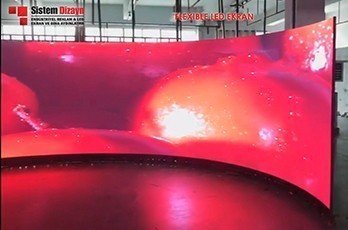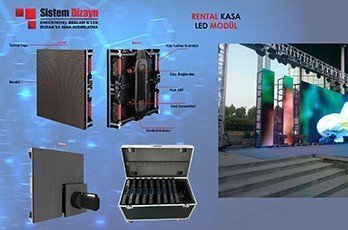LED displays are produced by combining RGB, which is green, red and blue colors. LED displays are formed by sequencing of specially produced, and clad LEDs (diodes). Thanks to the electric chips used, the light intensities are adjusted to provide different light intensities from each diode.
LED displays are produced according to variable number of pixels. In addition; LED displays are produced in line with their area of use, which means special for open spaces (outdoor) and closed spaces (indoor). The number of pixels per square meter on LED displays, plays an important role in the quality of LED displays.
The LED displays are generated by the sequential arrangement of LEDs, which are an electronic circuit component that emits light. These LEDs are long-lasting, enduring, very low power consuming and efficient light sources. LEDs can be examined in 3 classes;
1- SMD (Surface Mounted Device): It is the type of LED which is directly mounted on the PCB surface. SMD LED is the LED type we come across in many products. It is the type of LED used in many products such as; LED Strip, LED Module, LED display, Fluorescent LED and LED panel.
2- DIP (Dual Inline Package): LED type that is soldered on the bottom surface of PCB. It is widely used for decorative purposes and long legged. There are many models classified according to chip dimensions such as; 2835, 3014, 3030, 3528, 4014, 5014, 5050, 5060 and so on. It is used in Advertising Signs, Hose LEDs, Outdoor Megaboard displays.
3- COB (Chip on Board): Lumen values are quite high. It can be produced easily in different sizes and shapes. It is the LED technology used in products such as; Wallwashers, LED Projectors and some LED Panels.
What are the greatest advantages of LED displays?
Thanks to its modular structure, it can be produced in desired dimensions
Due to its high light intensity, high-quality images can be produced
Images can be viewed clearly on the LED display, even under the sunlight
No reflection is formed on the display
It is enduring and long lasting
It consumes low amount of energy
How to Choose LED displays?
1-Modules should be selected according to Usage Area
1.1) Fixed
1.2) Portable or Rentable (Rental)
2- According to position and location
2.1) Indoors
2.2) Outdoors
3-Pixel size according to the minimum distance at which the display will be monitored
≤3.91mm (min. 4 meters)
≤5.95mm (min. 6 meters)
6mm-10mm (between 6 meters and 10 meters)
≥10mm (more than 10 meters)
How to Assess Location of LED Display?
Site / area study and project analysis of the location that LED display will be placed
Static analysis
Determination of the control systems (Remote Management; HDMI, 4G, Wifi, Cat5, Cat6 or decentralized computing)
Determination of the module, transformer, internal chip, receiver and transmitter cards to be used according to the project, transfer to technical drawing, preparation of the proposal file
Setting of automatic brightness options for live broadcast and / or daylight
After the location assessment, the most suitable display option for your project should be selected.
Where are LED Displays used?
Shopping Centers
Stores
Markets
Banks
Hospitals
Hotels
Airports
Stadium and indoor sport facilities
Theaters
Meeting rooms
Concert areas
Mobile vehicles
Advertising industry
Public institutions
All companies, wishing to perform corporate communication
Avenues and squares
All of our LED displays have a warranty of 2 years, and our display cases have a warranty of 10 years. If requested, we have various warranty packages to extend the warranty terms.
To determine the ideal LED display, you can take support from our expert staff.









